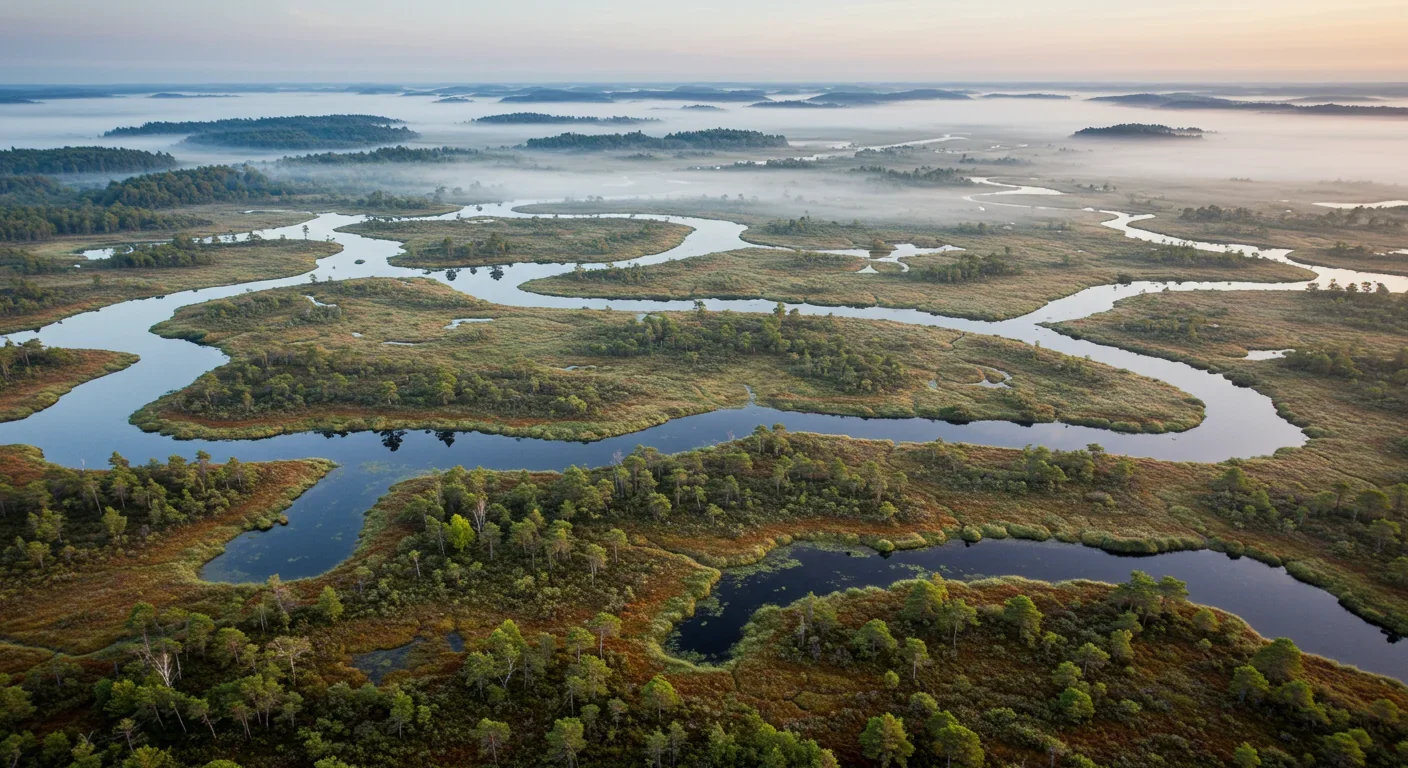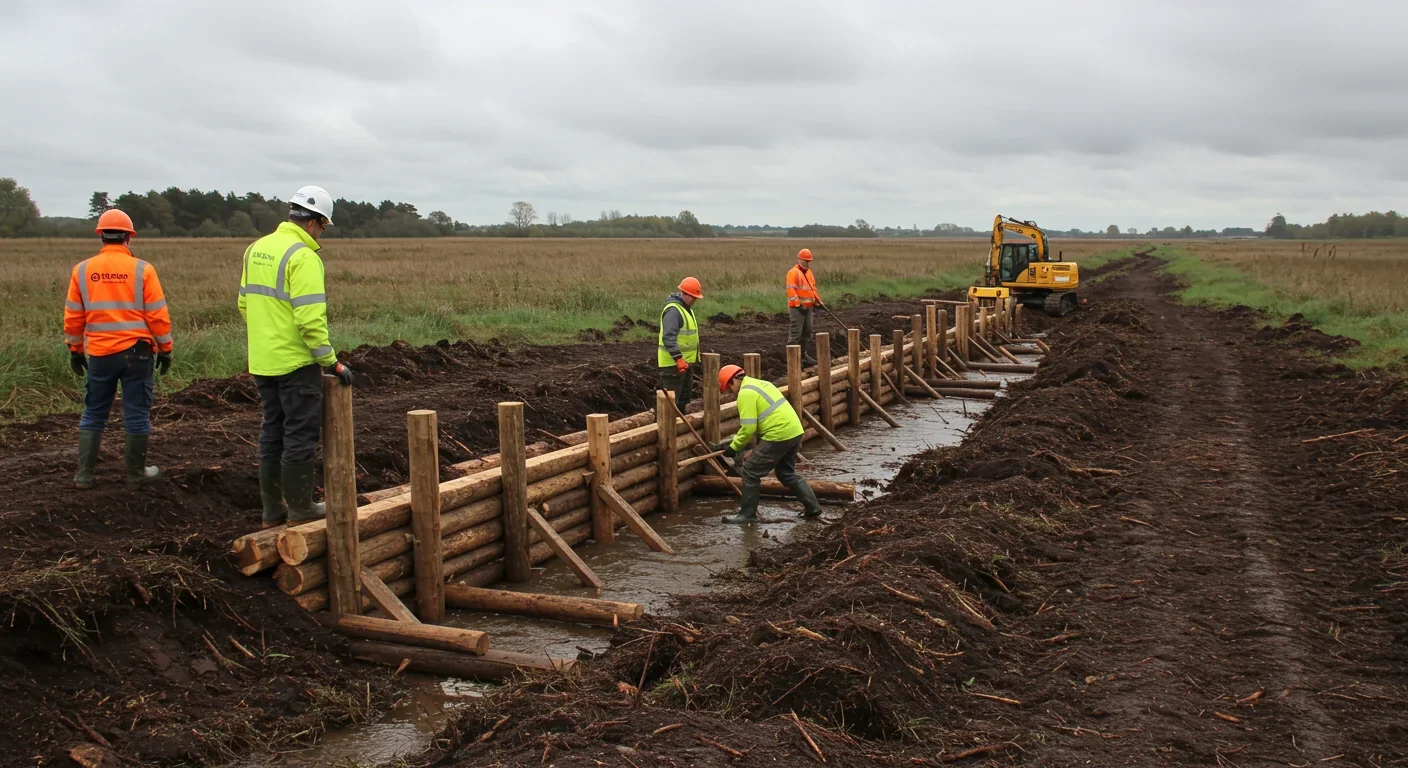Underground Air Storage: Renewable Energy's Hidden Battery

TL;DR: Peatlands store more carbon per acre than forests, but drainage has turned them into emission sources. Rewetting projects worldwide are reversing this damage by blocking drainage ditches and restoring water levels.

The climate crisis has forced us to think differently about solutions. While we've focused on cutting emissions from cars and power plants, scientists are racing to restore one of Earth's most powerful carbon storage systems. Peatlands cover just 3% of our planet's land surface, yet they hold more carbon per acre than all the world's forests combined. When drained for agriculture, these ancient wetlands release centuries of stored carbon. But here's the remarkable part: we can reverse the damage. By letting water reclaim these landscapes, rewetting projects worldwide are turning carbon sources back into carbon sinks, offering a tangible way to pull the climate crisis into reverse.
Peatlands are nature's unsung climate heroes. These waterlogged ecosystems—bogs, fens, mires, and swamps—contain partially decomposed plant material that has accumulated over thousands of years. Because they stay saturated with water, oxygen can't reach the organic matter to break it down completely. This creates a slow-motion preservation process where dead plants compress into thick layers of peat instead of rotting away.
The numbers are staggering. Despite covering only 3-4% of Earth's land surface, peatlands store approximately 30% of the world's soil carbon—roughly 550 gigatons. That's twice as much carbon as all forests on Earth. A single hectare of healthy peatland can lock away more carbon than any other terrestrial ecosystem.
But peatlands do more than store carbon. They regulate water flow, reducing flood risks during heavy rains and maintaining water tables during droughts. Research shows peatlands can absorb 100-1,300% of their dry weight in water, while mineral soils manage only 20-30%. This makes them crucial buffers against increasingly extreme weather.
Colombia's peatlands alone hold 1.9 billion metric tons of carbon—equivalent to 70 years of the country's fossil fuel emissions. Indonesia's tropical peatlands store even more, representing thousands of years of accumulated organic matter.
For centuries, humans viewed peatlands as wastelands ripe for conversion. Drainage ditches lowered water tables, transforming soggy bogs into farmland and tree plantations. This seemed like progress—turning "unproductive" wetlands into agricultural land.
But drainage fundamentally changes peatland chemistry. When water levels drop, oxygen penetrates the peat. Microbes that couldn't survive in waterlogged conditions suddenly thrive, rapidly decomposing organic matter and releasing carbon dioxide. What was a stable carbon vault becomes an active emission source.
The scale is breathtaking. Scientists estimate that drained peatlands worldwide release 860 million tonnes of carbon dioxide annually—roughly equivalent to Germany's total annual emissions. In some regions, peatland emissions represent the largest single greenhouse gas source.
Drainage also makes peatlands vulnerable to fire. Dry peat burns slowly, sometimes smoldering underground for months, creating massive smoke clouds. Indonesia's catastrophic 2015 peat fires released more daily emissions than the entire U.S. economy, sending half a million people to hospitals with respiratory problems.

Rewetting sounds simple: block the drainage ditches and let nature do the rest. In practice, it requires careful planning, engineering precision, and patience measured in decades.
The first step involves hydrological assessment. Engineers map historical water levels, analyze drainage infrastructure, and model how water will behave once barriers are installed. Getting this wrong can flood neighboring properties or create stagnant pools that harm the ecosystem.
Physical rewetting typically starts with blocking or removing drainage ditches, installing dams, weirs, and bunds to raise water tables. In Scotland's Flow Country, restoration teams have blocked over 900 kilometers of drainage channels since 2012. Similar projects in Germany have restored water levels across thousands of hectares, demonstrating that even heavily modified peatlands can recover.
The results aren't instantaneous. When water first returns, decomposition actually accelerates temporarily as newly flooded peat releases stored nutrients. But within months to years, the ecosystem shifts. Oxygen-loving microbes die off, decomposition slows, and the peatland begins functioning as a carbon sink again.
Plant communities respond predictably. Sphagnum mosses—the primary peat-forming species—slowly recolonize. These remarkable plants create their own acidic, waterlogged microenvironment. Within a decade, successful rewetting projects see substantial sphagnum coverage. Within several decades, the peatland can resume actively building new peat layers.
The Netherlands pioneered modern peatland restoration in the 1990s, recognizing that intensive agricultural drainage was literally causing the ground to sink. Dutch projects demonstrated that rewetting could stop subsidence, reduce CO2 emissions, and create new economic opportunities through paludiculture—farming on wet peatlands.
Scotland's Flow Country restoration represents one of Europe's largest rewetting projects. This vast expanse of blanket bog in the Highlands was heavily drained for forestry plantations in the 20th century. Since restoration began, the removal of non-native conifers and installation of peat dams has rewetted over 2,000 hectares. Carbon emissions have dropped measurably, and rare bird species like golden plovers are returning.
Indonesia faces perhaps the world's most urgent peatland crisis, with over 14 million hectares degraded or drained. The government's Peatland Restoration Agency has committed to rewetting 2 million hectares by 2030. Early results show promise—rewetted areas experience dramatically fewer fires, and local communities report improved water quality.
The United States has been slower to embrace peatland restoration, but momentum is building. Minnesota and Michigan have initiated significant rewetting projects in northern peatlands previously drained for agriculture. North Carolina is exploring restoration of pocosin wetlands along the coast.
The climate math behind rewetting is compelling. When peatlands are drained, each hectare can emit 10-30 tonnes of CO2 annually. Rewetting stops these emissions almost immediately, shifting the landscape from net source to net sink within just a few years.
Studies from restored peatlands in Europe show carbon emission reductions of 70-90% within five years of rewetting. After a decade, many sites become net carbon sinks again, actively removing CO2 from the atmosphere as new peat forms.
The potential global impact is enormous. Scientists estimate that restoring the world's 50 million hectares of drained peatlands could prevent 400-500 million tonnes of CO2 emissions annually—roughly equivalent to taking 100 million cars off the road permanently.
Carbon isn't the only metric. Rewetting generates measurable co-benefits for water quality, biodiversity, and climate adaptation. Research suggests that rewetted peatlands can reduce peak flood flows by 10-20% during extreme rainfall events, providing natural flood protection worth millions in infrastructure costs.
Biodiversity recovery happens faster than carbon sequestration. Wetland birds, amphibians, and invertebrates colonize rewetted sites within months. Plant diversity takes longer, but restored peatlands in Europe show species richness approaching natural reference sites within 15-20 years.
Rewetting peatlands requires significant upfront investment. Blocking drainage, removing plantations, and installing water control infrastructure costs $1,000-5,000 per hectare. For large-scale projects covering thousands of hectares, budgets quickly reach millions.
But long-term economics increasingly favor restoration. Continuing to farm drained peatlands requires perpetual drainage maintenance, fertilizer inputs, and climate adaptation measures. These costs compound over time, while rewetting creates a one-time expense followed by largely self-sustaining ecosystems.
Carbon markets are beginning to recognize peatland restoration as a valuable climate solution. Several methodologies for calculating carbon credits from rewetting have been developed, allowing projects to generate revenue from verified emission reductions. Indonesia's peatland restoration projects have already issued millions of carbon credits.

Paludiculture offers another economic pathway. This emerging practice involves farming rewetted peatlands with water-tolerant crops like sphagnum moss, cattails, and reed. German farmers are growing sphagnum commercially for horticulture markets, generating income while maintaining high water tables.
Tourism adds value too. Restored peatlands attract birdwatchers and nature enthusiasts. Scotland's Flow Country has become a destination for eco-tourism, supporting local economies in remote Highland communities.
International recognition of peatland importance has grown dramatically. The UN Decade on Ecosystem Restoration (2021-2030) specifically prioritizes peatland rewetting. The Glasgow Climate Pact included commitments from several nations to halt peatland degradation.
The European Union's Common Agricultural Policy now includes payments for peatland rewetting, making it financially viable for farmers to take agricultural land out of production. Germany has committed to protecting all remaining peatlands and rewetting significant areas by 2030.
Successful rewetting requires community buy-in, especially when projects affect agricultural land. Modern approaches prioritize participatory planning. In Indonesia, restoration projects work with village leaders to identify degraded peatlands where rewetting won't threaten current agriculture.
Indigenous communities manage over 25% of global peatlands, covering roughly 1.1 million square kilometers. Traditional knowledge about wetland management proves invaluable for restoration planning. Indigenous-led projects in Canada, Indonesia, and the Congo Basin demonstrate higher success rates than purely technical interventions.
Economic transition support makes rewetting more acceptable. Job training programs help agricultural workers shift to paludiculture, restoration work, or alternative livelihoods. When communities understand the climate, water quality, and flood protection benefits, support typically increases.
Despite growing momentum, peatland rewetting faces significant challenges. Land ownership fragmentation complicates large-scale restoration—projects often require cooperation from dozens of individual landowners.
Technical challenges arise in heavily modified landscapes. After decades of drainage, natural water flow patterns may be irreversibly altered. Subsidence can lower land elevation by several meters, making full hydrological restoration impossible.
Methane emissions during early rewetting concern some critics. Newly flooded peatlands can temporarily release methane—a potent greenhouse gas. However, research shows this effect is short-lived, and long-term carbon benefits far outweigh temporary methane increases.
Funding remains insufficient for the scale of restoration needed. While carbon markets are growing, current prices don't fully compensate for restoration costs, especially in remote sites. Climate change itself threatens peatlands, as rising temperatures accelerate decomposition even in waterlogged conditions.
The scientific case for peatland rewetting is overwhelming. The question now is whether political will, funding, and implementation capacity can scale up to match the urgency of the climate crisis.
Ambitious targets are emerging. The Global Peatlands Initiative aims to conserve all remaining pristine peatlands and restore 50% of degraded peatlands by 2050. Achieving this would prevent billions of tonnes of CO2 emissions while generating massive co-benefits for biodiversity and water security.
Technology could accelerate progress. Remote sensing using satellite radar can identify degraded peatlands and monitor water table levels across vast areas. Innovative financing mechanisms show promise—green bonds specifically designated for peatland restoration have raised hundreds of millions.
Research continues to refine rewetting techniques. Scientists are developing faster methods for establishing sphagnum moss, experimenting with different water management strategies, and identifying optimal approaches for different peatland types and climates.
For individuals wondering how to contribute, several pathways exist. Supporting organizations working on peatland conservation channels resources directly to restoration projects. Choosing peat-free gardening products reduces demand for peat extraction. Advocating for stronger peatland protection policies pushes governments to prioritize this climate solution.
The peatlands beneath our feet hold a climate legacy spanning millennia. We've spent the past century releasing that stored carbon back into the atmosphere. Now we have the knowledge, technology, and examples to reverse course. Rewetting won't solve the climate crisis alone, but it's one of the few solutions that works with natural processes rather than against them—and one that's already proving itself in landscapes from Scotland to Indonesia. The question isn't whether rewetting works. It's whether we'll act fast enough to protect and restore these irreplaceable carbon vaults before it's too late.

MOND proposes gravity changes at low accelerations, explaining galaxy rotation without dark matter. While it predicts thousands of galaxies correctly, it struggles with clusters and cosmology, keeping the dark matter debate alive.

Ultrafine pollution particles smaller than 100 nanometers can bypass the blood-brain barrier through the olfactory nerve and bloodstream, depositing in brain tissue where they trigger neuroinflammation linked to dementia and neurological disorders, yet remain completely unregulated by current air quality standards.

CAES stores excess renewable energy by compressing air in underground caverns, then releases it through turbines during peak demand. New advanced adiabatic systems achieve 70%+ efficiency, making this decades-old technology suddenly competitive for long-duration grid storage.

Our brains are hardwired to see patterns in randomness, causing the gambler's fallacy—the mistaken belief that past random events influence future probabilities. This cognitive bias costs people millions in casinos, investments, and daily decisions.

Forests operate as synchronized living systems with molecular clocks that coordinate metabolism from individual cells to entire ecosystems, creating rhythmic patterns that affect global carbon cycles and climate feedback loops.

Generation Z is the first cohort to come of age amid a polycrisis - interconnected global failures spanning climate, economy, democracy, and health. This cascading reality is fundamentally reshaping how young people think, plan their lives, and organize for change.

Zero-trust security eliminates implicit network trust by requiring continuous verification of every access request. Organizations are rapidly adopting this architecture to address cloud computing, remote work, and sophisticated threats that rendered perimeter defenses obsolete.